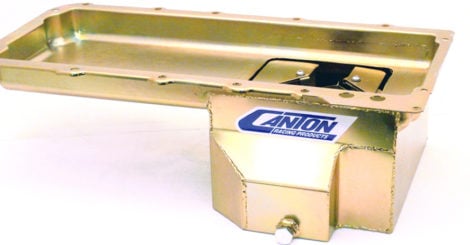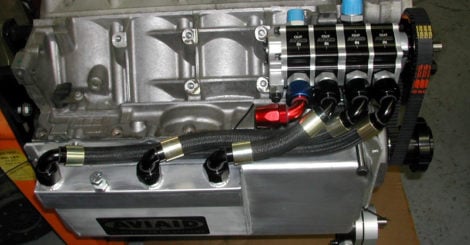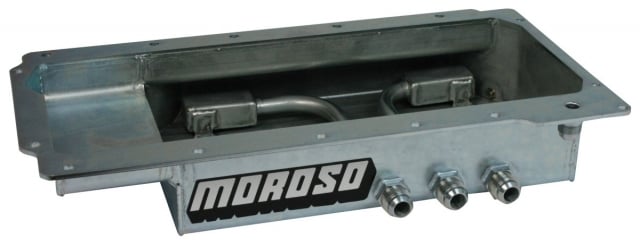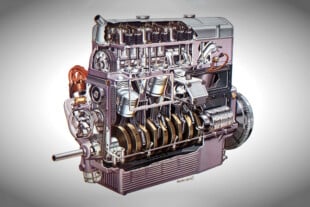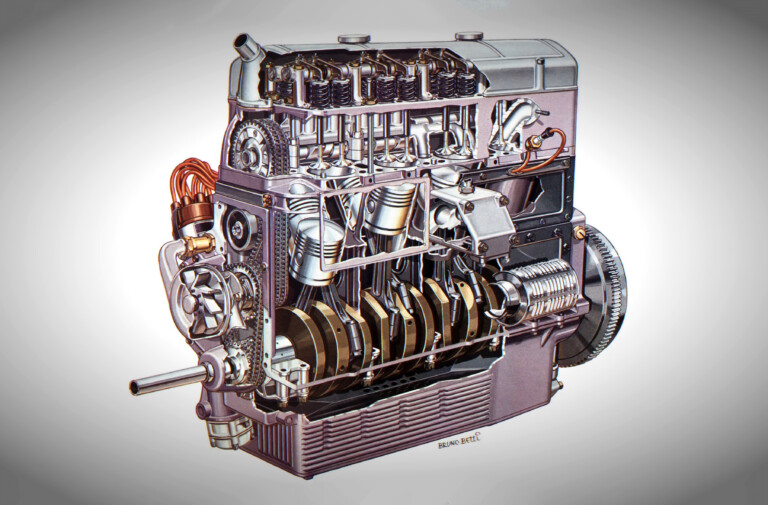 An automotive engine is a diverse collection of static and moving parts, ranging from the engine block to the crankshaft to cylinder heads, but without proper oil flow and control, none of those parts would be able to function properly.
An automotive engine is a diverse collection of static and moving parts, ranging from the engine block to the crankshaft to cylinder heads, but without proper oil flow and control, none of those parts would be able to function properly.
In fact, without controlling the flow of oil to the engine’s foundation, the moving parts would seize, potentially eating themselves and causing major destruction of the expensive components. The General Motors LS engine platform has a variety of different oiling methods employed through a diverse range of designs developed through the last decade, mainly to address issues that were discovered as performance levels increased.
The factory LS engine was never developed to build the type of horsepower it’s capable of today, and those real issues that have been identified over the years can seriously hinder performance. We’ve discussed those issues with some of the LS industry’s leaders, and by the time you’re done reading this article you’ll have a better handle on how to extract the most performance possible from your LS engine, no matter the application.
Factory Designs
There were two different major systems used in the original-equipment application – a wet sump design, where the oil is contained within the engine block and pan, and a hybrid wet/dry sump design that uses an external tank.

The factory oil pump in wet sump applications is bolted to the front of the block and driven via the crankshaft, pulling oil from a pickup in the oil pan.
The LS1/LS2/LS3/LS6 all used the traditional wet sump design, with the oil pump mounted to the front of the block and driven off the crankshaft through the use of a gerotor-style oil pump – great for packaging the pump and pan in a small form factor, but not so great for performance. The factory pan designs are very shallow, and the majority of the oil volume is housed up inside the deep-skirt block.
The deep skirt block can create more issues than it solves, however. The block is good from a strength standpoint, as it provides extra meat in high stress areas and secures the crankshaft well, but on the other side of the equation, it makes it difficult for the oil to return through the use of a traditional oil pan.
GM attacked the oiling issues by creating “windows” inside the factory blocks, allowing the oil a way to move throughout the lower half of the engine, but this also creates extra windage. One way to solve the issue of excessive oil use is through the use of an aftermarket block like the LS Next produced by Dart, but this doesn’t solve the problem for a racer with an existing engine.
Dick Maskin discusses the LS Next Block
Fear not, LS owners. Thanks to the work of a number of aftermarket companies like Aviaid, Armstrong Race Engineering, Moroso, Canton Racing Products, and Dailey Engineering, there are plenty of solutions to assist you in getting the most reliable horsepower possible from your LS-platform engine.
According to Aviaid’s John Schwarz, “The systems in stock form really aren’t terrible, but it became apparent fairly quickly that GM never really contemplated what people actually do with these cars. One of the problems that they’ve had over time is that engine development has quickly outpaced what they conceived, which has aggravated the demands on the oiling system. We’ve come across this situation a lot over the years with where we’re going today with engine technology, chassis technology and how that manifests itself in vehicle dynamics and the need to maintain oil pressure.”

The factory pump in both wet-sump and hybrid applications uses a crank-driven gerotor design and traditional pickup to supply oil to the engine.
On the LS7, LS9, and Corvette C6 Grand Sport, the oiling system has been modified from the other LS platforms, using an external oil tank to go with the same crankshaft-driven pump. The most important reason for GM building the system this way is to maximize oil control – by pulling the oil out of the pan and storing it externally, the issue of starving the engine of oil was supposed to be a thing of the past. As you’ll learn shortly, that isn’t exactly the case, for a few reasons.
“While the LS7 Z06 factory dry sump system is fine for street use, because of the high G capabilities of these cars, GM approached ARE in 2007 to design a “bolt on” retro fit system to allow the cars to hit the track and do what they are capable of,” says ARE’s Gary Armstrong. “This ‘from the drawing board’ system utilizes the well proven designs and scavenging capabilities of our LS1/LS6 systems in the LS7, still keeping the factory pumps and A/C. The LS7 engine is of course very popular in other types of cars, yet this system, and many of our others can be still be used.”
“It is a fairly simple upgrade, including an all new tank, and has become the number one engine mod for reliability in these engines. This system utilizes the same ultra-efficient windage tray design we use in all of our LS series dry sumps. The tray traps the oil as soon as it leaves the crankshaft, and retains it below, allowing the scavenge pumps to do their job. This system is also available in Stage 3 where we add another Roots pump to add even better scavenging. We are designing an all new system for the new Stingray 2014 Corvette, and the first units will be in production by late spring 2014, available from Katech.”
Upgrading The Factory Design
From The Factory
Chevrolet Performance Engineer Rocko Parker explains, “The Z/28, ZR1, Z06, GS C6, and LS9 used a hybrid dry sump design. We implemented dry sumps on those vehicles because of the lateral G capabilities and anticipated track usage.”
The new LT1 engine in the 2014 Corvette Stingray also uses a dry-sump oiling system. Parker says, “It’s very similar to the LS platform’s oiling system, but there are some differences due to the LT1’s variable vane oil pump and higher oil flows associated with the cam phasing, AFM, and Direct Injection system.”
One of the critical issues that crops up during competition use with the LS family of engines is excessive crank windage. Due to the deep skirt factory block, the crankshaft is constantly rolling around in the oil supply, and as RPM levels increase, the factory pans can actually become empty, starving the engine of lifeblood when it is most necessary.
One notable item brought to light is that the oil pump in past engines like the small-block Chevy was driven from the camshaft, which turns at half engine speed, and the LS-style pumps are driven at full engine speed from the crankshaft. “The issue that raises its ugly head in this situation is cavitation once you break the bounds of the factory operating parameters,” says Schwarz.
“We’ve done a number of steps to create different systems as the demand has driven us. Initially we created a hybrid dry sump system using the stock pressure pump and a grafted-on two section external scavenge pump to create essentially with the Z06 – GM did it internally, and we did it semi-externally.
“They started introducing better-flowing cylinder heads, larger-displacement engines, and freer-flowing intake and exhaust systems that allowed the engine RPM limits to go from what was originally 5,800 to what’s about the moon these days. Once we convert these cars over to an external pressure section and what we consider a properly configured dry sump system, we are able to solve the problem.”
The bolt-in Corvette Z06/LS7 conversion system from Aviaid is compatible with all of the factory components and helps to provide the oil control that the factory left unfinished. It allows the owner to retain the factory air conditioning, power steering, oil filter, cooler, tank and plumbing.
Moroso and Canton Racing Products offer many different oil pan styles, from stock-replacement wet sump pans to dry sump pans to swap pans for vehicles never supplied with an LS engine.
They provide a baffled tank insert for the factory tank that helps to control the oil and direct it towards the pickup, preventing starvation under hard cornering. The insert includes a stamped aluminum screen and foam breather element to help separate the air and oil. Also included in the kit is a cage insert and windage tray that gets installed into the factory pan to help control the oil and keep it in the sump rather than in the crankcase. The last part of the kit is the included single stage pump that works in conjunction with the factory scavenge pump to double the scavenge capacity and circulate the oil more efficiently. It mounts to the cylinder head and is driven with a belt through the use of a custom combination drive pulley that works with the stock serpentine drive.
External Solutions

ARE’s LS7 Dry Sump direct bolt-on pan replaces the factory oil pan and uses the factory internal dry sump oil pumps. It permits the air conditioner and other accessory-driven items to remain in place.
Armstrong Race Engineering also builds a solution that uses the C7’s internal pressure pump with one of their dry-sump pans and an external scavenge pump for LS7 owners. The air conditioner and other FEAD assemblies remain in place with this design.
ARE offers three stages of LS1/LS6 dry sump systems along with a multitude of other designs for different applications. Their Stage I system uses the stock internal pump for pressure, but uses a two stage scavenge-only dry sump pump that mounts to a modified A/C bracket/tensioner assembly and is driven via serpentine belt. The three gallon oil tank ensures that there’s a constant feed of clean oil supplied to the engine. ARE’s Stage I system also uses one of the company’s own cast alloy CNC machined, windage-tray-equipped dry sump pans. Also included is an ATI damper with 10% underdrive, new CNC-machined remote oil filter adapter, alloy catch can, Aeroquip fittings, and all necessary hardware. The system has been used successfully in many different road racing venues.
Once we convert these cars over to an external pressure section, and what we consider a properly configured dry sump system, we are able to solve the problems. – John Schwarz, Aviaid
Aviaid’s first step in upgrading the LS oiling system is the move to their LS-E external wet sump pump design. It provides increased volume and pressure adjustability, but keeps the oil within the engine block. By moving to the external pump, the company is able to drive the pump at half engine speed and remove much if not all of the cavitation induced by the internal pump configuration. It does so by driving the pump from a new crankshaft hub that accommodates the harmonic damper. This system mounts the pump directly to the block and includes a modified LS2 cast oil pan and drive belt and allows you to remove the factory oil pump.
The company’s LS-A system is designed for street and mild competition use. It uses the factory crankshaft-mounted pump to provide the oil pressure, then changes out the rest of the oiling system components to aid in oil control using a scavenge-only two stage pump and Gilmer drive gear.

Aviaid’s LS-A system is an ideal upgrade for street-car owners. Its design packages neatly in the engine compartment.
The pump mounts to the cylinder head with an included bracket, a choice of two different pans, three different sump tanks with different capacities, the drive pulley and lines and fittings. This system maintains its street manners by retaining the factory air conditioning, provides cooler operating temperatures, and eliminates parasitic horsepower loss through excessive windage.
For a more serious racer, the Aviaid LS-B system uses a two-section scavenge pump that mounts to the factory air conditioning bracket and offers the same oil tank and pan upgrades as the LS-A system. This system is driven from a new harmonic balancer from ATI that’s equipped with a special serpentine belt drive for the scavenge pump, yet retains the ability to use the OEM FEAD components.
Left - Aviaid's LS-D full dry-sump system is one of the most complete solutions for LS owners looking to get to the next level. Left Middle - Both dry sump pumps and external wet sump pumps are driven from a Gilmer-style toothed belt directly from the crankshaft. Right Middle - Dailey's integral system uses a CNC-machined billet pan. Right - This Peterson Fluid Systems' four-stage dry sump pump has four scavenge sections and one pressure section - this would be plenty of oiling capacity for all but the most extreme LS race engines. You'll see more engine vacuum using this design, which will help to produce even more horsepower thanks to the improved ring seal.
Serious Applications

ARE’s block-mounted four stage pump offers the ability to adjust oil pressure. It uses a Roots-lobe scavenge section and is driven from the crankshaft through the use of an HTD belt.
The main advantage to using a full dry sump design is complete oil control – while the wet sump design is acceptable in most applications, taking the oil out of the pan and running it through the external components takes crankshaft windage and oil aeration from the equation, in addition to removing the possibility for starving the engine for oil in high-G situations.
For full dry sump applications, ARE improves upon their Stage I system with their Stage II version, which includes all of the same components yet replaces the stock pressure pump with a dedicated three stage dry sump pump and adjustable pressure regulator. There is also an upgrade to the drive system using an HDT timing-style belt, and a different ATI damper with the proper drive system for the HDT belt. They also offer a Stage III system, which changes the pump for a four stage pump with three scavenge sections and one pressure section, along with a different pan. There are many different options available with ARE’s systems, so it’s best to call and speak with one of their technicians about your personal requirements prior to ordering.
According to Armstrong, “ARE builds over 11 different LS 1-9 dry sump systems, and while there will always be a need for our Stage 1 systems for street and track day applications, we specialize in ultimate no-compromise dry sump systems. Our Stage 3 systems have become the most popular, with the four-stage dry sump pump tucking in very close to and mounted directly to the block. It incorporates a three-lobe Roots scavenge section which optimizes the scavenging. Also, there’s our “fluidic” dry sump pan that has cavities to make oil even more accessible to the scavenge pumps. Our Stage 1 systems utilize the stock internal pressure pump, and somewhat simplifies the system, which are still available in 2 or 3 scavenges.”
He continues, “These systems are specified by several sanctioning bodies including the SCCA. Since the internal pump is now getting a constant supply of oil from the dry sump tank, it works extremely well; however, our Stage 3 systems will always be the ultimate. ARE also manufactures the “Spintric” air oil separator which mounts in the scavenge return line helping de-aerate the oil on its way back to the tank. These are optional, and can also be added at any time.”

Whenever a dry-sump oiling system is used, it’s necessary to have a filter at each scavenge port to prevent the pump from sucking up junk in the event of a parts failure. This ARE pan uses an integral windage tray to pull the oil away from the rotating assembly and send it out to the pump and tank.
Swap Stuff
There are many issues an oil pan builder faces when designing a pan to work for an application – most importantly, that it fits within the space and size requirements while still performing under pressure.
The LS has become one of the hot choices for racers looking to fast on a budget thanks to the wide and inexpensive availability.
Canton Racing Products and Moroso are on the hunt to provide a pan for nearly any vehicle. Canton offers a pan that will swap an LS engine into GM A, F, Y and X-Body cars for road-racing [PN 15-274].
In addition to their standard LS pan offerings, Moroso’s Custom Shop offers swap pans for many vehicles like an LS into a Nissan 240SX, LS into Miata, and LS into Trailblazer SS, among others.
Aviaid offers a number of full dry sump conversion systems targeted towards the serious racer who is looking for every last bit of performance from their LS engine. The versatile LS-C system includes a three-section pump that mounts directly to the block, a new stamped steel dry sump pan, windage tray, the aforementioned Super Damper drive system, and all lines and fitting elements to install onto your engine. This system provides the ability to regulate your oil pressure. They also offer the LS-D system which moves to a four- or five-stage pump.
Moroso’s Tri-Lobe line of dry sump pumps can be used in a variety of different applications. The tri-lobe scavenge sections have individual timing gears to ensure proper clearance, variable spring rates to help you optimize your oil pressure, and custom pressure section sides to provide increased efficiency. There are five different part numbers, so speak with one of their tech representatives to determine what’s best for you.
According to Moroso’s Thor Schroeder, “Dry sump oiling systems are the safest, most dependable oiling systems available. Horsepower gain is maximized because there is virtually no oil in the pan and no internal pump, allowing the windage tray or screen to run the full length of the pan. Other advantages of a dry sump system include a remotely mounted oil tank for increased capacity, the ability to easily add remote oil coolers, more consistent oil pressure, adjustable oil pressure, improved scavenging and increased ring seal due to greater oil pan vacuum.”
Peterson Fluid Systems’ R4 pump lineup features four-lobe rotors that flow in excess of 30 gallons per minute (for the high volume pump), ensuring that your engine will never be without the lifeblood it needs to stay alive. They feature a twisted rotor design in both the scavenge and pressure bodies, and are suitable for many different applications. Different part numbers apply for left and right sides, while a high-volume design is available for those combinations with a greater need for oil supply such as pin oilers and valvetrain sprayers. With a large selection of part numbers, it’s recommended to place a call to their tech line, where you can get help to figure out which style will work best for your application.

Peterson’s R4 line of dry sump pumps is offered in both driver and passenger-side fitments from one to six scavenge stages. Their upgraded rotor design featuring 1.4-inch thick rotors is recommended for drag racing, and there are provisions for a rear-mounted hex drive fuel pump.
“A dry sump system is always better than a wet sump if class rules and budget allow. The oil in a properly designed oil tank is always going to be less affected by g-forces than oil sitting in an oil pan so the pickup will stay covered. The oil in a dry sump is also de-aerated better due to it being outside of the wind storm that is happening inside the crank case and the process it will go through inside a properly designed oil tank,” says Peterson’s Mike Morten.
Dailey Engineering Integral Kit
Dailey Engineering builds custom dry sump oil pumps with Roots-style scavenge rotors and spur gear pressure sections.
Their dry sump oiling system for the LS engine platform utilizes a billet oil pan, a three- to seven-stage dry sump pump that’s integrated onto the oil pan, and will install on an LS wet sump or LS7 dry sump engine using an LS2 front cover. Unfortunately, you’ll have to pull out the air conditioning from your ride, but we suspect if you’re at the level where you need one of these systems, the A/C unit has long since made a trip to the scrapyard.
The newest iteration of Project BlownZ's engine uses a Dailey Engineering custom six-stage dry sump oiling system.
In Conclusion
We’ve documented the the LS engine platform deficiencies here along with a myriad of potential solutions. The deep skirt design of the block offers substantial power-handling advantages when paired with a proper oiling system upgrade, and has proven itself in countless road racing and drag racing applications. The vendors included in this article have spent many hours designing and testing systems that can handle the engine’s power requirements and oiling system demands – now it’s up to you to ensure that your LS engine is up to the task.






